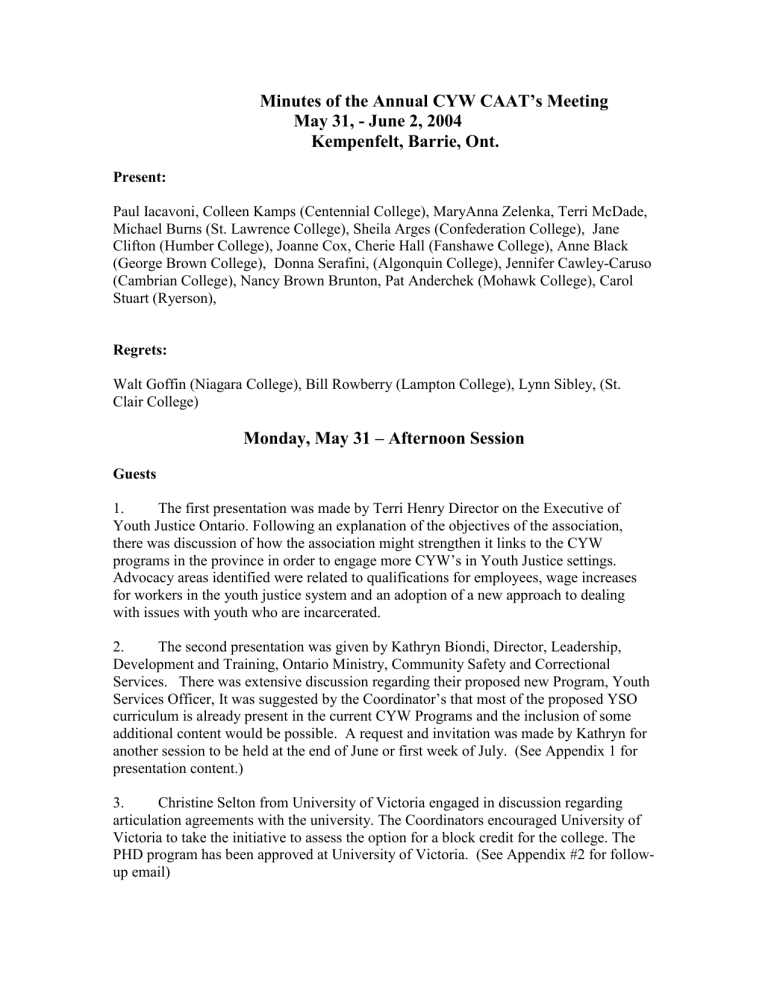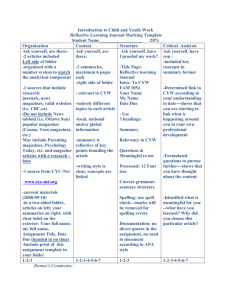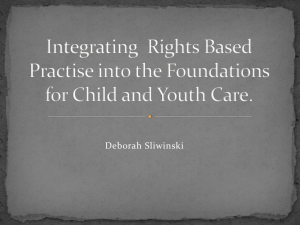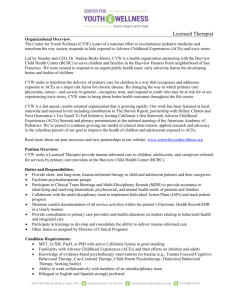here - CE Meeting

Minutes of the Annual CYW CAAT’s Meeting
May 31, - June 2, 2004
Kempenfelt, Barrie, Ont.
Present:
Paul Iacavoni, Colleen Kamps (Centennial College), MaryAnna Zelenka, Terri McDade,
Michael Burns (St. Lawrence College), Sheila Arges (Confederation College), Jane
Clifton (Humber College), Joanne Cox, Cherie Hall (Fanshawe College), Anne Black
(George Brown College), Donna Serafini, (Algonquin College), Jennifer Cawley-Caruso
(Cambrian College), Nancy Brown Brunton, Pat Anderchek (Mohawk College), Carol
Stuart (Ryerson),
Regrets:
Walt Goffin (Niagara College), Bill Rowberry (Lampton College), Lynn Sibley, (St.
Clair College)
Monday, May 31 – Afternoon Session
Guests
1. The first presentation was made by Terri Henry Director on the Executive of
Youth Justice Ontario. Following an explanation of the objectives of the association, there was discussion of how the association might strengthen it links to the CYW programs in the province in order to engage more CYW’s in Youth Justice settings.
Advocacy areas identified were related to qualifications for employees, wage increases for workers in the youth justice system and an adoption of a new approach to dealing with issues with youth who are incarcerated.
2. The second presentation was given by Kathryn Biondi, Director, Leadership,
Development and Training, Ontario Ministry, Community Safety and Correctional
Services. There was extensive discussion regarding their proposed new Program, Youth
Services Officer, It was suggested by the Coordinator’s that most of the proposed YSO curriculum is already present in the current CYW Programs and the inclusion of some additional content would be possible. A request and invitation was made by Kathryn for another session to be held at the end of June or first week of July. (See Appendix 1 for presentation content.)
3. Christine Selton from University of Victoria engaged in discussion regarding articulation agreements with the university. The Coordinators encouraged University of
Victoria to take the initiative to assess the option for a block credit for the college. The
PHD program has been approved at University of Victoria. (See Appendix #2 for followup email)
4. Colleen Kamps, Centennial College provided an update on their apprenticeship program and OYAP. She indicated that there may be an apprenticeship program beginning out of Connestoga.College which has no Post Secondary CYW Program.
5. Report from the OACYC a. We’re moving from a Branch structure to a Committee structure. The remaining 3
"branches" are now Regional Committees and we're developing committees to represent sectors in the profession: yours (education); a hospital-based CYC committee to be formalized at our June meeting; a school-based committee still in planning process. b. Scope of Practice statement is completed; the plan is to elaborate it for particular sectors. The greatest need for this has come from the hospital-based CYCs so it will likely be the first. c. Code of Ethics (developed in 1985) requires revision, and planning is underway for this (collection of materials, etc.) d. Group Car &/or Home Insurance package for members due to be in place this fall
(average savings for members will pay for their membership 5 times over, that is, save them that amount, based on our initial estimates). e. Provincial Conferences planned for 2005, June 1-3, at Mohawk in Hamilton; also
Sudbury in 2007, Toronto in 2009 -- our 50th Anniversary f. Membership growth slowing down but still growing: just over 1600 total (775 Full, 730
Students
The Hamilton 2005 Conference theme is likely to be "Teaching and Learning" (partly with an emphasis on school-based CYC) but this could also include teaching & learning by those in the field/or coming into college/ university CYW programs, and they are invited to present/ participate.
.
Questions were addressed by Terri on behalf of the OACYC regarding insurance coverage, accreditation and the publication of numbers of students from each college.
It was suggested that the educator’s group will bring forward to the board ideas related to ways to recognize strategies to increase student membership and assure participation of the OACYC on program advisory committees.
2. CCCCYC
Carol Stuart presented an update on the efforts of the CCCCYC to move towards professional regulation.
3. OESC
Pat Anderchek gave a Presentation from Bob Williams of the Ontario Education Services
Corporation. Anne Black who has used the agency outlined the process for obtaining
CPIC through the OESC. See Appendix #3 for an outline of the content from the presentation.
Tuesday, June 1 – Educator’s Day
Objectives for the Day:
To come together as a community of educators in Child and Youth Work
To connect, re-connect, support, share ideas, concerns and resources
Ice Breaker #1:
“Which Muppet are You?” Personality Quiz
Ice Breaker #2:
Index Card Exercise
In a few words, list
What is your hope for today?
What do you want to take away today?
What do you hope to contribute today?
Share your index card with the group
Issues Brainstorm
classroom management
innovative teaching strategies
use of media in the classroom
field placement models and evaluation
common course names, standardization of curriculum?
admission – criteria etc.
Morning Sessions:
Educators shared resources for courses in a variety of curriculum strands. There was a request to evaluate whether there were common course titles that emerged, and areas where curriculum has common themes across the colleges. The chart created by Susan
Leslie-Berkis was distributed to guide discussions at each table.
Feedback was that there were some courses that appeared to lend themselves to common course titles (ie Legislation) but even here, not all colleges teach a specific legislation course.
Afternoon Sessions:
Ryerson Family Work Curriculum
Carol Stuart presented an overview of the family work course presently being taught by
Thom Garfat at Ryerson. Tom is utilizing a textbook edited by him. He makes use of live video demonstrations throughout the course. Carol showed several video clips to demonstrate the course content.
Focus Group Results:
Focus Group #1: Classroom Management
Strategies: consistency, follow-through, set ground rules and look for opportunities to enforce.
Reinforce positives
Review the code of conduct
Complete and file code of conduct reports
Set an expectation about demonstrating “field behavior” in the classroom
Give “the look”
Use silence to gain students’ attention, or raise your voice on occasion if warranted
Deal with issues sooner rather than later
Set the tone for your classroom right at the beginning
Role model the behavior you expect
Engage the students in a problem-solving process
Ask students to leave if needed
Act “as if” the students are adults
Move students forward in the class just before you begin – late students can then find a seat in the back so they don’t disrupt others.
Focus Group #2: Innovative Teaching Strategies
Strategies: cooperative learning strategies by Idalynn Karr is a valuable resource in 1st year, design stable groups of 4 students for 5 weeks then switch groups for 5 weeks then switch again so that students get to know a range of classmates.
Week long orientation where 2 second year students adopt 4 first year students
Taking photographs of students helps with getting to know students. Encourage students to introduce themselves directly to you in a creative way to enhance name retention
Use of team, as opposed to individual testing to reduce students anxiety and to enhance group work and accountability.
Focus Group # 5 : Admission :
College Name # of
Full-Time Faculty
Mohawk College
# of
Part-Time
Faculty
12
Humber College
Confederation
Fanshawe
Centennial
Centennial Apprenticeship
George Brown
Algonquin College
St. Lawrence (Kingston)
St. Lawrence (Brockville)
Ryerson
College Name
4 4/5 (6 but 2 F.T. are seconded elseswhere)
6 (.5 seconded elsewhere)
3
7
8
1
9
3
5
2
10
6-8
13
6/8
20
10
15
2
7
Mohawk
Humber
Confederation
Fanshawe
Centennial
Centennial Apprenticeship
George Brown
St. Lawrence
Ryerson
# of
Full-Sessional
Faculty
1
3
2004 - # of 1 st yr intake
(Sept)
120 + 50
55 (Reg)
32 (Accelerated)
42
Sept – 84
145
160
100
80
3 rd
year - 75
2004 - # of
1 st yr intake
(January)
50
55 Reg
2004 - # of
Students in
Program FT
May 04 – 210
Sept 04 – 330
+ 50
55 (Reg)
87
N/A
25
Jan 04 – 440
350
398
180
No Admission Criteria other than
Grades
(e.g. grade 12)
Yes
No
No
Yes
Yes
90 hrs of volunteer work with CYW Yes
No
CATT CYW B Yes
Mandatory
Orientation
Yes
Application / Questions /
Volunteer Work / Life
Experience
Other criteria used
Yes
No
No
Yes mark in Grade 12
English
English Grades
English Grades
English Grades
English Grades
No
Questionnaire
No
Employment (CYW)
English Grades
None
Resume / Work Experience No
Evaluation:
Will you take away at least one thing that you will use from today’s session? If so, describe.
How often would you like to see an “Educator’s Day”?
Suggestions for next time?
Other comments?
Next CAAT Meeting:
Tuesday, June 2 - Morning Session
Host: Fanshawe College, Joanne Cox - Chair
Date: possibly connected to OYCYC conference in Hamilton; June 1, 2, 3 2005 –or May
24, 25, 26, 2005---not available in the lodge, but in the main building; otherwise June 6,
7, 8 for the lodge (although may interfere with grad dates) or May 30, 31—Monday &
Tuesday prior to the conference. Consensus reflects the dates of May 24, 25, 26 as the best dates.
Proposed location in St. Mary’s, Joanne will explore costs, possibly tentatively book
Kempenfelt until confirmation is made elsewhere.
Additional items: a. Role of CAATS group: raised by Joanne Cox; concern re: influence of this group and leadership role; Suggestions: electronic meetings throughout the year re: accreditation, common themes, advocacy role for CYW as a profession; who takes on the responsibility for the lead in this task? Fanshawe for 2005, St. Lawrence for 2006 (Supported by Mike
Burns). b. Thank you to Susan Leslie-Berkis for collecting all college information in compact format for quick reference; possibly post course outlines on the website
(http://spin.mohawkc.on.ca/cyw/caat/);
Action: Susan Leslie-Berkis will remind all coordinators to send –e-copies of all course outlines for posting to the provincial site or direct links to program websites and curriculum. c. Discussion centered on college representation and those who are not attending with an invitation to be part of the process. Thank you to Pat Anderchek for her website development and a formal request for her ongoing involvement with CAAT’s to continue to develop the website. d. Program Reports: submissions attached (Pat Anderchek reminded each college to email the report within the next week).
e. Additional items: concerns have been addressed through the program reports, group discussion and informal connections throughout the past two and a half days.
Many thanks to Mohawk College for their hospitality and organization.
Appendix 1 - Kathryn Biondi
Presentation
“Proposed” Vocational Learning Outcomes Youth Worker Programs
Presented to: Coordinators of post secondary programs:
Correctional Worker Child and Youth Worker
Contact: Kathryn Biondi
Director, Leadership, Development and Training
Ontario Ministry, Community Safety and Correctional Services kathryn.biondi@jus.gov.on.ca
905-548-5010
Youth Services Officer
1985 – YOA - Ministry of Correctional Services assumes serviceresponsibility for Phase
II young offenders ages 16 – 17
Ministry of Community and Social Services retains service responsibility for young offenders aged 12 – 15
Correctional Officers working with youth – grade 12
Minimal Young Offender/Adolescent focused training content
September 1996 a young offender is beaten to death by his “cell partner” in a shared facility
Youth Services Officer
1999 - inquest recommendations – 119 in total including the creation of “Youth Worker” position and training that reflects the unique aspects of that work
Youth Worker Recruitment and Training Committee begins to work on recommendations relating to the classification
Ministry of Correctional Services commitment to Dedicated Stand Alone Youth
Facilities
2000 creation of “dedicated 6 week training curriculum”
Youth Services Officer
April 1/2003 Youth Criminal Justice Act
Announcement of integration of Phase I and II into Youth Justice Services Division of
MCSCS
April 1/2004 Creation of Ministry of Children and Youth Services
April 1/2004 Cabinet approval of YSO position
Category Youth Worker – Classification Youth Services Officer
Competency based
Youth Services Officer
Work with young people between the ages of 12 and 17
Direct Operated Facilities – currently ages 16 – 17
On the job expectations:
Development, implementation and evaluation of Case Management Plans
Selection and implementation of appropriate Behaviour Management strategies based on a sound understanding of child development
Working with other professionals in a Multi-Disciplinary Team environment working towards pro-social community reintegration of young person(s)
Knowledge of therapeutic programming and treatment approaches
General overview of behavioural disorders, dysfunctional behaviours, abnormal and deviant psychology, various sociological issues, cognitive behavioural interventions, mental health
To work in a custody/treatment environment that utilizes all of the principles of
Relationship Custody
Synopsis of the “proposed” Vocational Learning Outcomes Youth Worker
Programs
The graduate has reliably demonstrated the ability to
1. work in a manner consistent with professional ethics and practice, a respect for others, and relevant law.
2. counsel clients (individually and in groups), and foster and utilize therapeutic relationships and environments* (residential and non-residential), that involve varying degrees of custody, respecting diversity, promoting well-being and facilitating positive behaviour change for children, youths, and their families.
3. collaborate with other service providers to establish and maintain constructive working relationships in order to enhance the quality of service for children, youths, and their families.
4. assist in the prevention of crisis situations by observing relationships, recognizing changes in individual and group dynamics and selecting and implementing appropriate behaviour management techniques to promote stability and effect positive change using methods consistent with organizational and legal requirements.
5. respond to crisis situations/emergencies as required/directed and in compliance with all organizational and legislative requirements.
6. design and implement strategies which promote client* advocacy and community education to enhance psycho-social development in children, youths, and their families.
7. maintain security of the institution by employing static and dynamic security techniques based on and integrated with a sound understanding and demonstrated ability to apply the principles of Relationship Custody to protect the safety of clients, staff and the community.
8. work within a Case Management Model, focusing on the Habilitative, Rehabilitative and Community Reintegration Needs of Children and Young People utilizing a Multi-
Disciplinary Team Approach, involving effective intervention strategies meeting the client*’s service and treatment goals.
9. apply knowledge of the fundamental concepts of psychology, sociology, and criminology in dealing with clients, peers, supervisors, other professionals, community based service providers and the public.
10.create, plan, and implement recreation* and leisure* programs and special events which respond to identified needs and maximize the delivery of the personal, social, environmental, and economic benefits which focus on the effective use of leisure time within a facility or agency programming model.
Appendix 2 – Christine Selton
Hello Pat:
Thank you for making room in your agenda for a brief discussion regarding the value of developing articulation agreements with the BC consortium of
Child and Youth Care and an update from the University of Victoria. As promised, I am sending a brief summary.
Articulation Transfer agreements with BC Consortium of Child and Youth Care:
First, I would like to clarify the current block transfer agreement that is in place. All students from recognized CYW/Human Service programs who have completed their program with a minimum GPA of "B" are granted block credit or 30 units upon acceptance into the School of Child and Youth Care,
University of Victoria (or acceptance into other degree granting member institutions of the BC Consortium of Child and Youth Care). Some diploma graduates may receive waivers for the three unit normative development requirement and three unit English requirements upon review of the diploma.
As discussed in the meeting, this block credit arrangement does not include specific child and youth care course credit and, therefore, does not include a waiver of our second year Child and Youth Care Courses: CYC 200A, CYC
200B, CYC 201, CYC 252. If any of your members wish to pursue an articulation agreement, it may be possible to waive some or all of these courses. To date, this process has been at the initiation of the individual programs. I would be pleased to provide support for institutions choosing to pursue this option.
For more detailed information on the BC Consortium of Child and Youth
Workers programs, please refer to the BC Consortium website: http://www.cycec.bc.ca/
Update from the School of Child and Youth Care, University of Victoria:
The School of Child and Youth care has recently received final provincial approval for the delivery of a PhD in Child and Youth Care. Curriculum development is now underway and we will be accepting our first class of students in September 2005 (applications deadline in January of 2005)
The MA Program in Child and Youth Care continues to flourish. The fourth cohort will begin their program in the fall of 2004. While we continue to look for flexible delivery methods, there has been a movement to ensure that students have a rich on-campus experience at the school. We recognize the value of engaging our graduate students in research and as teaching
assistants while providing an opportunity to enjoy a collegial environment for their studies.
The undergraduate program in the School of Child and Youth Care is nearing completion of a comprehensive curriculum review. This research project is grounded in the work of SCYC, the CYC Education Consortium of British
Columbia, and the North American Certification Project (NACP). The results of the review will allow the School to adjust its curriculum, where necessary, to be in full alignment with the NACP competencies. The mechanisms developed by SCYC for the systematic curriculum analysis can serve as a template for other educational programs wishing to do a similar analysis. A standard curriculum model for Child and Youth Care post-secondary programs across North America will be a big step forward for the CYC profession and the educational preparation of practitioners.
Thank you again for the opportunity to meet with the Ontario Child and Youth
Workers programs. I look forward to continuing to build relationships with you and with your colleagues.
NOTE: Some of your members expressed interest in receiving a copy of the
NACP. I have attached an electronic copy and have also provided the website. http://www.acycp.org/nacp.htm
--
Christine Shelton
Program Director Distributed Learning
School of Child and Youth Care
University of Victoria
PO Box 1700 STN CSC
Victoria, BC V8W 2Y2
Email: cshelton@uvic.ca
PH 250-721-7988
Fax 250-721-6374
School of Child and Youth Care: http://web.uvic.ca/cyc/
AMTEC http://www.AMTEC.CA
Appendix 3 - Pat Anderchek for Bob Williams
Ontario Education Services Corporation
La corporation des services en éducation de l’Ontario
(OESC)
Presentation to
Ontario Colleges of Applied Arts and Technology
Deans/Chairs of Community Studies
Wednesday, May 26, 2004
OESC
Non-Profit Corporation (Ontario), 2002
“Owned” by all School Boards’ Associations in Ontario
Written contract with all Boards in the province to provide police record check services
OESC
Boards are required to “collect” police record checks on all staff and “service providers” –
Regulation 521/01 as amended by
Regulation 322/03 ( Education Act )
OESC
“Service Providers” has been interpreted broadly and now includes anyone who has direct and regular contact with students
Contracted services
Students at Faculties of Education (Canada and U.S.)
Public Agencies (e.g. CCAC’s, Treatment Centres)
Volunteers
OESC
OESC has completed over
200,000 record checks on staff and service providers of school boards
OESC
OESC is interested in providing services to
organizations that have staff/students who must be in contact with vulnerable populations
Public Health
VON
Archdiocese
Girl Guides
OESC
OESC is already providing services to some
Colleges for students enrolled in programs that have practicum assignments working with vulnerable populations
George Brown College – Child and Youth Worker Program
Sheridan College – Educational Assistants Program
St. Clair College – Early Childhood Educators Program
OESC
From the Colleges’ point of view, the services are
Easy
Efficient
Protect privacy of students
Credible
No Cost to the College
OESC
OESC has a contract with the Oxford Community Police Service to provide the police record checks
OESC
OESC adjudicates all records, using an expert panel and a credible, thorough procedure which is sensitive to the privacy and concerns of individual students
OESC
Students who are deemed to be “an acceptable risk to the safety of students” (no police record or record presents an acceptable risk) receive a unique, plasticized OESC
ID Card which must be carried, together with a piece of valid photo-identification when in schools
OESC
The OESC ID Card is accepted by all School Boards and by some other agencies
OESC
All OESC procedures have been scrutinized and established with the assistance of several lawyers and a judge, and meet Freedom of Information requirements
OESC
OESC ID Cards can be issued for up to 3 years – the norm is 1 school year
OESC
Costs (to cover OESC actual costs only – no profits) are borne by individual students who apply directly to OESC
OESC
If your college is interested, contact Sue Nordien, Manager OESC to register you program and tell her approximately how many students will require an OESC ID Card
OESC will send you:
A pro-forma letter which you can put on your letterhead and adapt to your program requirements, and give to each student – it explains the requirement for the checks, gives background on OESC and how to obtain the police record check and OESC ID Card
An original (electronic) Consent Form (to be provided by the College to each student)
An original Payment Form (to be provided by the College to each student)
OESC
Costs to the Student for this service
(Money Order, Visa or MasterCard) are:
$25 (plus GST) for a one-year card
$35 (plus GST) for a three-year card
A one-year card can be renewed for two additional years for $15 (plus GST)
OESC
Lead Time –
Our experience tells us that the sooner your students receive the Letter, Consent
Form and Payment Form from the College, the more likely it is that they will have their
OESC cards by September
OESC
Questions?
OESC
Contact Information –
Bob Williams bwilliams@opsba.org
Sue Nordien snordien@opsba.org
Tel: 416-340-2540
Fax: 416-593-7858
Appendix 4 – Program Reports
CENTENNIAL COLLEGE CHILD AND YOUTH WORKER PROGRAM
Highlights of the past year;
--- NEW WINTER 2004 INTAKE (one section - 40 students
For the first time we implemented a winter intake of first year students. This was to accommodate the double cohort of the previous year, and was in addition to the three sections (145 students ) of first year admitted in the Fall 2003 semester. -- Second year students - 115 --- Third year students ---93
-- Implementation of Revised Curriculum
All courses, except for 2 English and required General Education courses are now CYW core courses. Several first year Community Services courses were revised and assimilated.
Substantial increase to hours of classroom time in Psychopathology courses.
--- A very successful Career and Information Fair with over 30 Agencies/School
Boards/Associations participating and over 300 students.
Challenges;
--- Increase in the use of part-time faculty --- Closure of the Warden Woods campus, with CYW
Program moving to the Progress Campus (Hwy. 401 and Markam Rd.) for the 2004 Fall semester.
FANSHAWE COLLEGE
CHILD AND YOUTH WORKER PROGRAM UPDATE
CAAT MEETING: May 31, June 2, 3, 2004
The 2003/2004 Academic year saw the next phase in the expansion of the Child and
Youth Worker Program at Fanshawe College. In September there were two sections in each of the first and second year intakes. In January 2004 the first section of the CYW program at the Woodstock campus began. These changes have increased the overall numbers of full time students from 240 to 320. By September 2004 those numbers will increase again by 40 and next January by another 40. The final step will bring the total numbers from 240 to 450.
This evolution has resulted in increased hiring opportunities including the first new full time position in 17 years. The development of new placement opportunities has also occurred.
There has been a message from the community that agencies are finding an increase in children in care who are identified as having developmental challenges. We will be looking at ways to expand both theory and practice in the current course curriculum to better prepare our graduates for the realities of interacting with these children.
We have now adopted a policy of “D” instead of a “C” as a passing grade, as Fanshawe institutes a GPA system. Our attrition continues to be very low, and our KPI and
Instructional Feedback results place us at the upper end in both the division as well as the
College at large.
Applicant numbers have returned to the levels we have traditionally seen prior to the influx of numbers in the past few years. Division wide, we are looking at continuing to improve our marketing so as to not become complacement. Generally we are fortunate, given the struggles of other programs to attract applicants.
For the most part, this has been a successful year. I look forward to the future as inevitably the addition of a new full time faculty and new students will fire up the old engine.
Humber College Report
the CYW Program is taking a slightly larger intake as of Fall 2004, increasing from 45 to 55 students. This was a compromise to the College request that we take an additional section, which we felt uncomfortable with given the lack of additional fulltime Faculty and the pressure on Field Placements in the area.
with the current ratio of part-time to full-time Faculty, there is a considerable demand on Faculty time to provide training and support to these individuals. This has been particularly an issue with regards to the management of classroom behaviour, and plans are underway to develop a more organized and proactive approach to offering this professional development.
work is complete on our implementation of Generic Employability Skills into our curriculum, and we are open to enquiries from other CYW Programs that are just beginning this project.
we have continued to experience stress around the timely completion of Criminal
Record Checks for Field Placement. We will be pursuing the service offered by
OSEC.
we are beginning down the path of a curriculum review slightly different from the one that has been ongoing for several years. Our Advisory Board has always played a role in reviewing our courses, one at a time, to ensure currency, etc.
However, at this point we have decided to examine our curriculum in a holistic way, to ensure that everything that needs to be covered is, and that there is not unnecessary overlap. In addition, we examine how various courses build on and complement each other over the three years. We have just completed first year, and will share these results with our Advisory Board in the Fall.
our Accelerated Program has been highly successful, with intake rising from 19 in
2002 to 32 in 2004. These students work very hard over 4 semesters to complete the Program in a compressed way, and adjustments to their workload have been necessary, but they generally tend to excel academically. Their experience in
Field Placement is very similar to that of the regular students in terms of challenges, and generally there has been significant improvement in their response to some of the self-exploration required in our Program.
Mohawk College Report
Program Numbers
September Intake 2001 - 65/91 Graduates, 17 honors
September Intake 2002 - 61/98 -Year 3, 4 males
September Intake 2003 – 58/105 3 males
September Intake 2004 – 155?
January Intake 2002 - 27/45 -Year 3, 4 males
January Intake 2003 – 31/40 – Year 2, 2 males
January Intake 2004 - 52 -Year 1, 8 males
Highlights
‘Bullying vs Basketball- One on One’ October 30, 2003
-146 CYW students acting as moderators after the play ‘The Diary’
‘Bullying vs Basketball- One on One’ October 28, 2004
Community Based Projects
Week of the Child and Youth – October 2003
-Working with Children and Youth - What a Privilege!’ - VincieTravale
-Dr. Jean Clinton, Monday Oct. 18th, 2004
Child Abuse Council-Program Committee
-Dr. Frank Stechey – Community Presentation April 2004
Research – CURA Grant- Partnership with McMaster University
Challenges
Double cohort, younger students
Change Year 1 placement experience from 4 days to 3 days each week and located in school based settings which is more structured and closely supervised by College. (pilot fall 2003)
Classroom behaviour
Content revisions
-manual,
Increased Numbers
Program Mapping
CURA
Faculty Hiring
Youth In Conflict with the Law
Continuing Education
Sharing of learning technologies
Constant change…
Thanks from Pat Anderchek for the many years of involvement with the CAAT group.
As of September 2004 Nancy Brown Brunton has assumed the Program Coordinator role along with her present role of Field Placement Coordinator.
Ryerson CYCP Director’s Report
June 2004
1.
Student Admissions, Enrolment, Graduation
P02/W03 P2003 F2003 W2004 P03/W04 P2004 F2004
Admitted
F2001/
W2002
52
(25+ in
Jan 02)
82
24
5
75
+2 readmit
40
10
25
+3 readmit
1
0
100
+5 readmit
41
10
36
15 (cond)
1 re-ad
(112 apps)
Ineligible
Accepted but declined
Course
Enrolment
# of students
73
Graduating 8
Estimated
Active
180 (max in winter)
21
102
17
179
16
193 na
193 (max in winter)
33
250
20
2.
Program Course Offerings
Required Courses
CYC505 Human Services Management
F03
C
W04
DE
S04
Internet Only
C DE
CYC601 Social Research Methods
CCYC602 Children’s Rights
DE
CYC605 Advanced Therapeutic Interventions
CYC702 Ecological Approaches to Child and Youth
Care Practice
CYC705 Program Evaluation
DE
C
C
C
Internet with Intensive July 6-9
Internet with Intensive June 25-27 &
July 10,11
CYC047** Professional Issues
C/DE C/DE
DE DE
CYC048** Independent Study *
Elective Courses
CCYC802** Incident Response for Children and Youth
CCYC803 Advocacy in Child and Youth Services
CCYC800 Intensive In Home Family Support
CCYC801 Psycho-educational Support Programming
CCYC804 Integrated Case Management
CCYC805 Special Issues: Program Development
DE
Distance: Internet
3.
Instructors and Faculty
Carol Stuart (Director CYC702/CYC048)
Francis Hare (CYC601/CYC505/CYC705/ CYC048/ CYC047)
Part-time
Kim Snow (CYC047/CYC048/CYC602/CYC605)
Sheldon Riensilber (CYC505)
Tina Payette (CYC702/CYC605) (Instructor at Humber)
Anne Black (CYC702) Program co-ordinator at GBC
Nancy Mayer (CYC802)
Murray Stainton (CYC601/CYC705)
Thomas Garfat (CYC800)
Judy Finlay (CYC602)
4.
Course Development and New Curriculum
CCYC803 Child Advocacy scheduled for January 2005
CCYC805 Intensive In-Home Family Support is currently being offered in Spring
04. Dr. Thom Garfat.
CCYC800 Special Topics: Program Development currently under development.
Stephanie Estabrook, one of our graduates is the course developer. Offered in Fall
04.
CCYC804 Integrated Case Management will be developed by Carol Stuart to be offered in Spring 05.
The CYCP proposal for funding from Microsoft Canada intended to support our course development and experiment with additional design technology over a 5-year period as well as to evaluate our efforts went to
Microsoft, however through a combination of errors the deadline was ‘missed’ by university advancement and Microsoft will advise when they are accepting proposals again.
5.
Faculty Research
Carol Stuart is working on a project entitled “Understanding The Relationship
Between Client Outcomes, Childhood Resilience, And Quality Of Care In
Residential Care and Treatment” based on a research partnership with several
OARTY agencies.
Francis Hare has been working with PARC to develop a research database for tracking clients and examining the issues involved in transitions out of care. He has recieved CERIS funding to examine the issue of ‘unaccompanied refugee minors’ as they leave the child welfare system.
Kim Snow has applied for research grant funding to enable youth at risk to take
CYC602: Children’s Rights. The project is entitled “Access to Education through
Rights Education”.
Sheldon Reinsilber joins Kim Snow with an appoint as an adjunct faculty
(honourary position-no salary implications).
6.
CYC-related Professional Activities of Faculty
Carol has just finished with a sub-committee of the Association of Child and
Youth Care Practitioners (ACYCP) a written examination for the NACP that will be pilot tested in the United States. She continues to work with the CCCYCA on professional regulation for child and youth care in Canada. Carol is sitting on the child welfare standards advisory committee for the Canadian Council on Health
Services Accreditation to develop national accreditation standards for child welfare programs.
7.
Additional Items
The CYCP website now has the letter of intent for a 4 year degree program. A motion will come to School council in September for the approval of the full program proposal which will be developed over the summer. The Provost will provide feedback on the letter of intent at the end of June.
The budget review for the part-time program has resulted in a projected increase so that we will be able to fully fund the courses planned and CE will be able to run separate sections of the courses at the same time as we are running program versions.
Carol and Francis have a paper on the program revisions being published in a special edition of the Child and Youth Care Forum on educational issues.






